The coronavirus disease (COVID-19) primarily spreads through respiratory droplets when infected people cough and sneezes. A recent update from health agencies confirms that the virus can spread through airborne particles.
The severe acute respiratory syndrome coronavirus 2 (SARS-CoV-2) can spread through aerosols that can hang in the air for long periods. However, it has not been easy to assess the actual environmental threat since there are no procedures and tests present.
Now, a team of researchers at the University of Maryland presented a simple approach that can potentially provide information about the prevalence of SARS-CoV-2 in the atmosphere at any location.

Schematic representation of sample collection and analysis for mass detection (top) and simplified layout of the hospital ward indicating the positions of various dehumidifiers during September 3-10, 2020

 This news article was a review of a preliminary scientific report that had not undergone peer-review at the time of publication. Since its initial publication, the scientific report has now been peer reviewed and accepted for publication in a Scientific Journal. Links to the preliminary and peer-reviewed reports are available in the Sources section at the bottom of this article. View Sources
This news article was a review of a preliminary scientific report that had not undergone peer-review at the time of publication. Since its initial publication, the scientific report has now been peer reviewed and accepted for publication in a Scientific Journal. Links to the preliminary and peer-reviewed reports are available in the Sources section at the bottom of this article. View Sources
The study
There are shared similarities between SARS-CoV-2 and other coronaviruses such as the Middle East respiratory syndrome coronavirus (MERS-CoV) and the severe acute respiratory syndrome coronavirus (SARS-CoV), both of which were found to be airborne and could spread even in long distances. It is essential to study how SARS-CoV-2 could spread to reduce the risk of infection.
Published on the pre-print server medRxiv*, the researchers aimed to see the extent and prevalence of SARS-CoV-2 infection in the air. To arrive at the study findings, the researchers used a portable dehumidifier as a convenient and affordable tool to collect airborne SARS-CoV-2 virus in the condensate.
They situated the dehumidifiers in selected areas of a hospital ward with patients who reported flu-like illness, which could be COVID-19. These dehumidifiers stayed there over three separate periods in one week. The team studied the samples frequently for both the virus envelope protein and SARS-CoV-2 RNA.
What the study found
The researchers have found that in several samples across separate areas, the condensate from dehumidifiers tested positive for the presence of SARS-Cov-2.
“Our results point to a facile pool testing method to sample the air in any location in the world and assess the presence and concentration of the infectious agent to obtain quantitative risk assessment of exposure, designate zones as ‘hot spots’ and minimize the need for individual testing which may often be time-consuming, expensive and laborious,” the researchers concluded in the study.
The team believes that the simple test highlights the need for an effective but easy-to-do technique to detect the virus in high-density environments. Being able to understand the day-to-day exposure risk to virus aerosols is crucial to implement fast and reliable interventions to contain the spread of the virus, as well as safeguard human health.
Further, the method could be used when there is the unavailability of individual testing in many remote areas. This way, the presence of the virus particle in the air could spark infection control measures to stop the spread of the virus.
Overall, there are now more than 38.4 million people who have been infected with SARS-CoV-2 and over 1 million people who died from complications.
The United States remains the nation with the highest number of cases, topping 7.9 million, followed by India, with over 7.23 million infections.
Airborne spread
Ten months into the pandemic, many health experts described that COVID-19 could spread via aerosols, given the fast spread of the virus across countries. Many cases were traced back to enclosed areas with little ventilation, hinting that the virus may have spread through the air.
Both the World Health Organization (WHO) and the U.S. Centers for Disease Control and Prevention (CDC) said that there are pieces of evidence that show the airborne transmission of SARS-CoV-2. The agencies recommend that people should wash their hands regularly, maintain social distancing, and always wear a mask, especially when going out. Further, the agencies emphasized that staying indoors in areas where there is poor ventilation could elevate the risk of contracting the virus.

 This news article was a review of a preliminary scientific report that had not undergone peer-review at the time of publication. Since its initial publication, the scientific report has now been peer reviewed and accepted for publication in a Scientific Journal. Links to the preliminary and peer-reviewed reports are available in the Sources section at the bottom of this article. View Sources
This news article was a review of a preliminary scientific report that had not undergone peer-review at the time of publication. Since its initial publication, the scientific report has now been peer reviewed and accepted for publication in a Scientific Journal. Links to the preliminary and peer-reviewed reports are available in the Sources section at the bottom of this article. View Sources
Source:
Journal references:
- Preliminary scientific report.
Moitra, P., Alafeef, M., Dighe, K., Ray, P. et al. (2020). Rapid and Low-cost Sampling for Detection of Airborne SARS-CoV-2 in Dehumidifier Condensate. medRxiv. https://www.medrxiv.org/content/10.1101/2020.10.08.20208785v1
- Peer reviewed and published scientific report.
Moitra, Parikshit, Maha Alafeef, Ketan Dighe, Priyanka Ray, James Chang, Aaron Thole, Benjamin Punshon‐Smith, et al. 2021. “Rapid and Low‐Cost Sampling for Detection of Airborne SARS‐CoV‐2 in Dehumidifier Condensate.” Biotechnology and Bioengineering 118 (8): 3029–36. https://doi.org/10.1002/bit.27812. https://onlinelibrary.wiley.com/doi/10.1002/bit.27812.